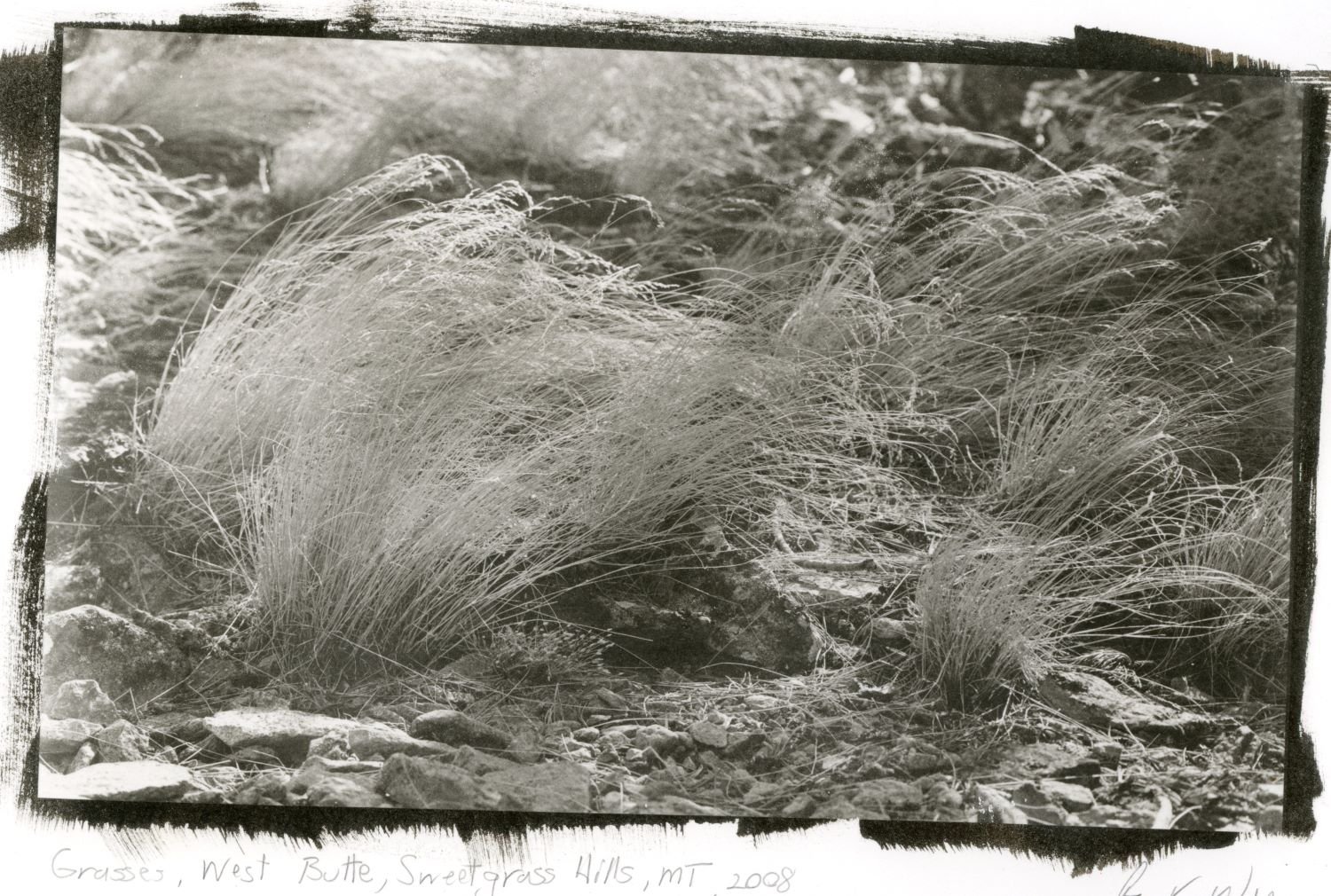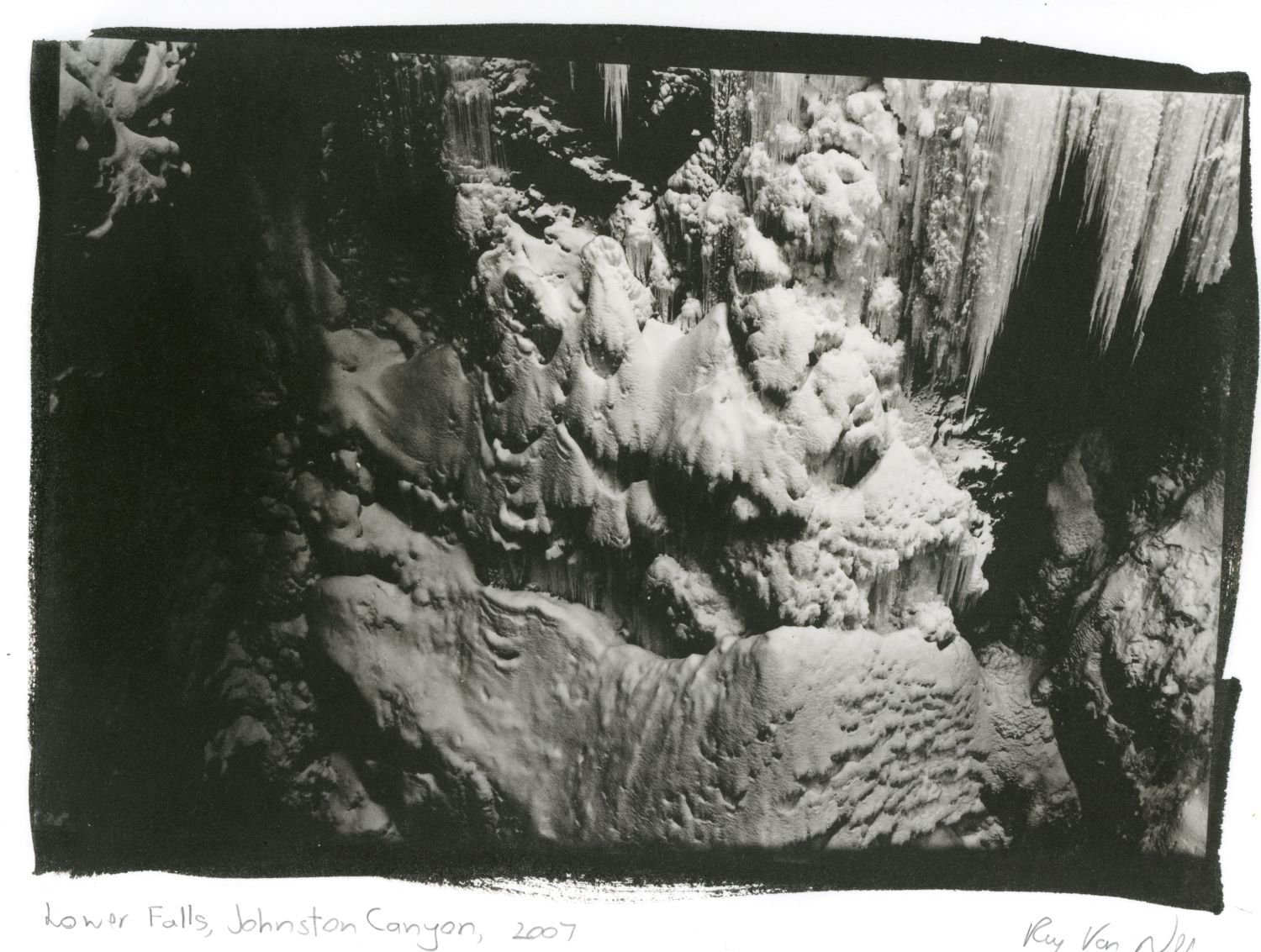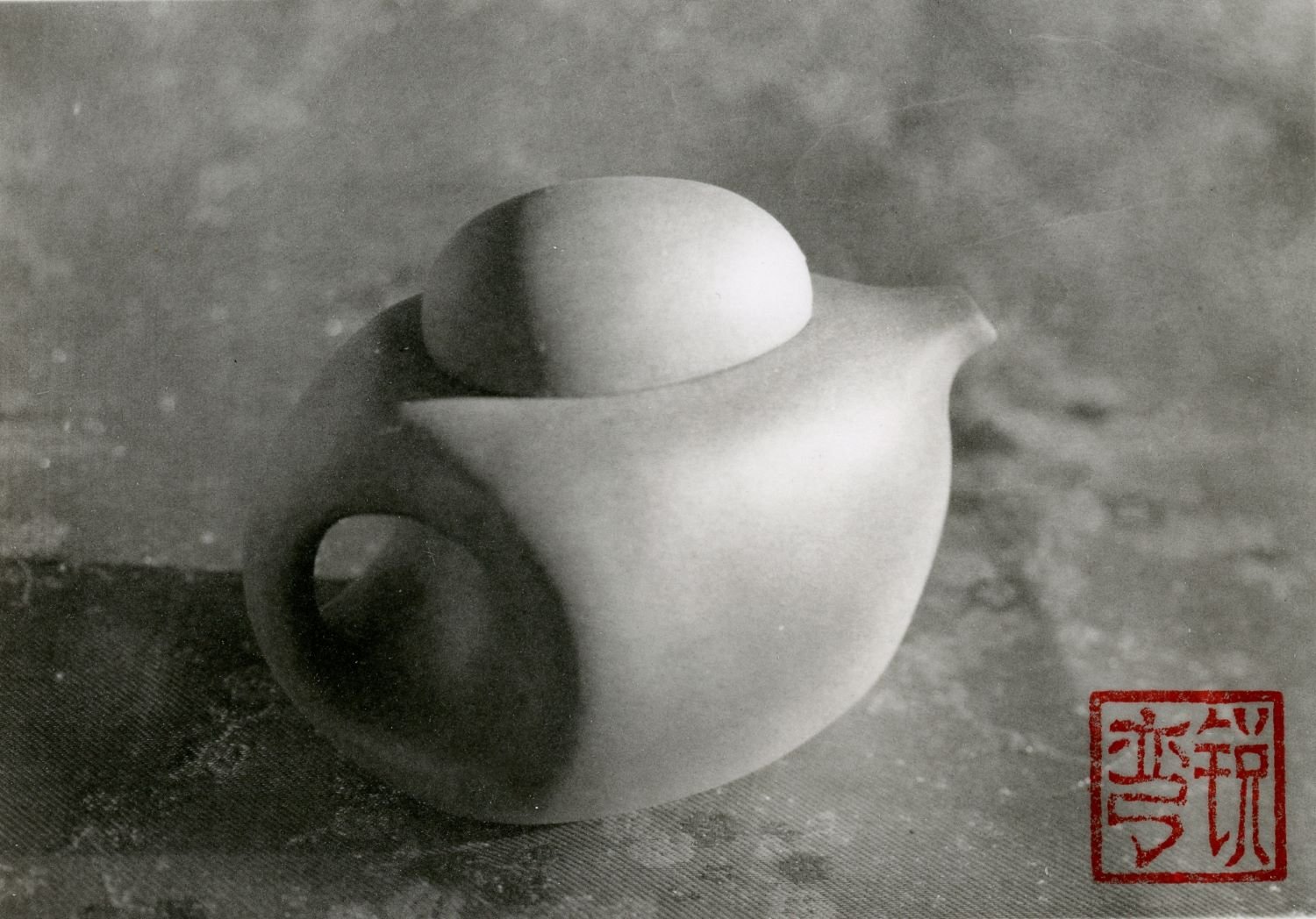Ray van Nes
Intimate Landscapes…
‘still working in platinum, they are essentially intimate landscapes…’ Ray hand-coats the paper with platinum, hence you can see the brush-marks.

Elbow Falls, 2013, platinum / palladium contact print, 5 x 7 inches, framed, $450 Cdn.

Outcrop, Sheep River, platinum / palladium contact print, 5 x 7 inches, framed, $450 Cdn.

Grasses, West Butte, Sweetgrass Hills, MT, 2008, platinum / palladium contact print, 6 x 9 inches, framed, $600 Cdn.

Elephant Rocks, 2005, platinum / palladium contact print, 7 x 9 inches, framed, $600 Cdn.

Hillside, Kelowna, BC, 2008, platinum / palladium contact print, 7.5 x 9.5 inches, framed, $600 Cdn.

Streamlet, Asulkan Valley, 2007, platinum / palladium contact print, 7 x 9.5 inches, framed, $600 Cdn.

Boulder, Elbow Falls, 2011, platinum / palladium contact print, 9.5 x 7.5 inches, framed, $600 Cdn.

Sandstone Outcrop, 2008, platinum / palladium contact print, 7.5 x 9 inches, framed, $600 Cdn.

Roots, Bullcreek Hills, 2008, platinum / palladium contact print, 9.25 x 7.25 inches, framed, $600 Cdn.

Huang Shan #2, 2017, platinum / palladium contact print, 4.75 x 11.5 inches, framed, $600 Cdn.

Lower Falls, Johnston Canyon, 2007, platinum / palladium contact print, 6.5 x 9.5 inches, framed, $600 Cdn.

Calabash Lake, Kham, 2007, platinum / palladium contact print, 10.5 x 10 inches, framed, $850 Cdn.

Horsetails, Sir Sanford, BC, platinum / palladium contact print, 13.5 x 10 inches, framed, $850 Cdn.

Ice, Memorial Falls, MT, 2008, platinum / palladium contact print, 15.5 x 11 inches, sold.
The platinum / palladium print exhibition Yixing Teapots, by Calgary photographer Ray van Nes, stemmed from a small-scale still life project involving a baker's dozen of Chinese terracotta tea pots, a Shu Dynasty inspired teacup, as well as a Moose Jaw teapot called Love Monster.

Dragon Teapot #5, 2023, platinum / palladium print, 4.5 x 6.5 inches (11.5 x 16.5 cm), unframed $300.00 Cdn or framed (metal) $450.00 Cdn.

Bamboo Teapot, 2023, platinum / palladium print, 4.5 x 6.5 inches (11.5 x 16.5 cm), unframed $300.00 Cdn or framed (metal) $450.00 Cdn.

Bamboo Teapot #2, 2023, platinum / palladium print, 4.5 x 6.5 inches (11.5 x 16.5 cm), unframed $300.00 Cdn or framed (metal) $450.00 Cdn.

Basket Teapot #2, 2023, platinum / palladium print, 4.5 x 6.5 inches (11.5 x 16.5 cm), unframed $300.00 Cdn or framed (metal) $450.00 Cdn.

Celadon Teapot, 2023, platinum / palladium print, 4.5 x 6.5 inches (11.5 x 16.5 cm), unframed $300.00 Cdn or framed (metal) $450.00 Cdn.

Coin And Ingot Teapot, 2023, platinum / palladium print, 4.5 x 6.5 inches (11.5 x 16.5 cm), unframed $300.00 Cdn or framed (metal) $450.00 Cdn.

Shu Dynasty Prince Teacup, 2023, platinum / palladium print, 4.5 x 6.5 inches (11.5 x 16.5 cm), unframed $300.00 Cdn or framed (metal) $450.00 Cdn.

Love Monster Teapot, 2023, platinum / palladium print, 4.5 x 6.5 inches (11.5 x 16.5 cm), unframed $300.00 Cdn or framed (metal) $450.00 Cdn.

Henry Moore Teapot #3, 2023, platinum / palladium print, 4.5 x 6.5 inches (11.5 x 16.5 cm), unframed $300.00 Cdn or framed (metal) $450.00 Cdn.

Person Character Teapot, 2023, platinum / palladium print, 4.5 x 6.5 inches (11.5 x 16.5 cm), unframed $300.00 Cdn or framed (metal) $450.00 Cdn.

Plum Blossom Teapot #3, 2023, platinum / palladium print, 4.5 x 6.5 inches (11.5 x 16.5 cm), unframed $300.00 Cdn or framed (metal) $450.00 Cdn.

Prince Gong, Gazing At The Moon Teapot #3, 2023, platinum / palladium print, 4.5 x 6.5 inches (11.5 x 16.5 cm), unframed $300.00 Cdn or framed (metal) $450.00 Cdn.

Rabbit Hair Glaze Teapot, 2023, platinum / palladium print, 4.5 x 6.5 inches (11.5 x 16.5 cm), unframed $300.00 Cdn or framed (metal) $450.00 Cdn.
‘still working in platinum, they are essentially intimate landscapes…’
Unlike silver print processes, platinum lies on the paper surface, while silver lies in a gelatin or albumen emulsion that coats the paper. As a result, since no gelatin emulsion is used, the final platinum image is absolutely matte with a deposit of platinum (and/or palladium, its sister element which is also used in most platinum photographs) absorbed slightly into the paper.
Ray hand-coats the paper with platinum, hence you see brushmarks.
Ray Van Nes is a self-taught analog fine art photographer working in monochrome using Modernist principles. He works with the 19th century process of platinum/ palladium and with silver gelatin prints. Within these guidelines, he seeks to find abstraction in both the natural and manmade environment. The one major exception is the series “Worthy of Their Hire”, which is a portrait series of working craftsmen in Alberta.
He has had both solo and group shows since the late 1980s. In the early 1990s, at the City of Calgary Archives, Ray exhibited 5x7 palladium prints based on built environments. That body of work is in the National Architectural Archives at UofC. Remnants was another project, involving images of early 20th century industrial architecture in Turner Valley, Medalta (Medicine Hat, Alberta) and Claybank (Saskatchewan), where he used enlarged negatives, mostly 11x15 in. with some 16x20 or bigger. The series was exhibited at the Royal Alberta Museum and the Art Gallery of Calgary. One of the artist’s Sandstone Series images is part of the Billboards Project by the City of Calgary's Civic Art Collection. Beyond the National Architectural Archives, his work is also found in the Alberta Foundation for the Arts Permanent Collection, the City of Calgary Collection and in private collections in Canada and the United States.
The exhibition Yixing Teapots, by Calgary photographer Ray van Nes, stemmed from a small-scale still life project involving a baker's dozen of Chinese terracotta tea pots, a Shu Dynasty inspired teacup, as well as a Moose Jaw teapot called Love Monster.
Depictions of everyday items are wonderful windows into the past and present. Using a platinum / palladium print process, the photographer has imbued these material objects with life, glorifying their form, meaning, and charm. The images recognize the value of mindful contemplation while going about the simple rhythms of familiar tasks.
“Last winter , I did a little still life project of our terracotta Chinese tea pots. About a baker’s dozen. There is one tea pot which is not Chinese but terracotta and a tea cup which is from the Shu Dynasty ( museum shop) which is not a tea pot. I made small prints in a process known as platinum/palladium. I have incorporated my chop into the image.”
***
In an area of southern Jiangsu Province by Lake Tai (not far from Shanghai) during the Song Dynasty - 10th C. AD - the local clay was used to make small teapots for use with the strong oolong type teas. They were sold in the vicinity of the Golden Sands Temple in Yixing, which was popular with scholars and those studying for the bureaucrat exams. The types of teapots we think of today as typical of Yixing came to prominence during the Zhengde Emperor’s reign during the Ming Dynasty, with an ever-increasing variety of designs and forms. There are a few exceptions to the Yixing teapots in the series, one is a lidded teacup that comes from the San Xing Dui Museum in Guanghan Sichuan, in the form of one of the ancient shu dynasty bronzes of the head of an ancient local king (ca. 360 BC). It is, however, made of the same clay as traditional Yixing pottery. There is a rabbit hair glaze porcelain teapot from Beijing, and a celadon glaze teapot from Jingdezhen. Finally, there is the love monster teapot made in Moose Jar (Saskatchewan) of similar clay to Yixing by a local potter who studied in China.
Part of Exposure Festival 2024.
